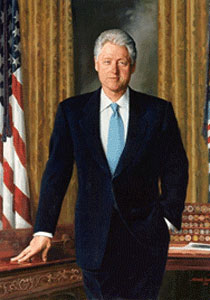Difference between revisions of "William Jefferson (Bill) Clinton"
| Line 1: | Line 1: | ||
[[Image:Clinton-portrait.jpg|thumb|Portrait of President Clinton.]] | [[Image:Clinton-portrait.jpg|thumb|Portrait of President Clinton.]] | ||
'''William Jefferson (Bill) Clinton''' is the forty-second President of the United States. | '''William Jefferson (Bill) Clinton''' is the forty-second President of the United States. | ||
| + | |||
| + | Clinton writes briefly in his autobiography ''My Life'' of his thinking with regards to the characteristics of his presidential library: "I had thought a lot about the library and its exhibits on my years as President. Each President has to raise all the funds to build his library, plus an endowment to maintain the facility. The [[National Archives]] then provides the staff to organize and care for its contents. I had pored over the work of several architects and had visited many of the presidential libraries. The overwhelming majority of people who visit them come to see the [[exhibits]], but the building has to be built in a way that preserves the records. I wanted the exhibit space to be open, beautiful, and full of light, and I wanted the material presented in a way that demonstrated America’s movement into the twenty-first century." | ||
| + | |||
| + | In ''My Life'' Clinton notes that he selected the architect [[James Polshek]] "largely because of his design for the Rose Center for Earth and Space in New York, a huge glass-and-steel structure with a massive globe inside." [[Ralph Appelbaum]] was selected to make the exhibits as he believed "his work on the Holocaust Museum in Washington was the best I had ever seen." Polshek later noted that Clinton "was the worst client he had ever had: if he came to see me after a six-month hiatus with only a minor change in the drawings, I would notice and ask him about it." | ||
| + | |||
| + | Clinton explained the choice to site his library in Little Rock in the book as well. "I felt I owed it to my native state and because I thought the library should be in the heartland of America where people who didn’t travel to Washington or New York would have direct access to it. The city of Little Rock, on the initiative of Mayor [[Jim Dailey]] and city board member Dr. [[Dean Kumpuris]], had offered twenty-seven acres of land along the Arkansas River in the old section of town, which was being revitalized and was not far from the [[Old State Capitol]], the scene of so many important events in my life." | ||
| + | |||
| + | ==References== | ||
| + | |||
| + | Bill Clinton, ''My Life'' (New York: Vintage, 2004), 875-876, 967. | ||
| + | |||
| + | ==External links== | ||
| + | |||
| + | [[Category:Living people]] | ||
Revision as of 21:33, 22 December 2007
William Jefferson (Bill) Clinton is the forty-second President of the United States.
Clinton writes briefly in his autobiography My Life of his thinking with regards to the characteristics of his presidential library: "I had thought a lot about the library and its exhibits on my years as President. Each President has to raise all the funds to build his library, plus an endowment to maintain the facility. The National Archives then provides the staff to organize and care for its contents. I had pored over the work of several architects and had visited many of the presidential libraries. The overwhelming majority of people who visit them come to see the exhibits, but the building has to be built in a way that preserves the records. I wanted the exhibit space to be open, beautiful, and full of light, and I wanted the material presented in a way that demonstrated America’s movement into the twenty-first century."
In My Life Clinton notes that he selected the architect James Polshek "largely because of his design for the Rose Center for Earth and Space in New York, a huge glass-and-steel structure with a massive globe inside." Ralph Appelbaum was selected to make the exhibits as he believed "his work on the Holocaust Museum in Washington was the best I had ever seen." Polshek later noted that Clinton "was the worst client he had ever had: if he came to see me after a six-month hiatus with only a minor change in the drawings, I would notice and ask him about it."
Clinton explained the choice to site his library in Little Rock in the book as well. "I felt I owed it to my native state and because I thought the library should be in the heartland of America where people who didn’t travel to Washington or New York would have direct access to it. The city of Little Rock, on the initiative of Mayor Jim Dailey and city board member Dr. Dean Kumpuris, had offered twenty-seven acres of land along the Arkansas River in the old section of town, which was being revitalized and was not far from the Old State Capitol, the scene of so many important events in my life."
References
Bill Clinton, My Life (New York: Vintage, 2004), 875-876, 967.
